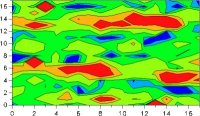Detecting voids behind
pavings or behind voussoirs with the MIMP 16
|
In addition to controlling
the integrity of piles, the MIMP 16 allows to detect voids
by the impedance method.
A software specially developed
for this method makes it possible to perform a large number
of measurements very rapidly.
|
 |
The principle
:
Scanning a paving by the mechanical
impedance method aims at detecting the areas of void between the
body of the paving and the shape.
Let us briefly remind that it deals with
a vibration method. A sound wave is created from a shock of known
strength. The velocity of the wave is recorded by the MIMP 16
by means of a geophone positioned upon the element to test.
Studying the signal allows one to know whether
the paving rests on its substrate correctly or not. In order to
evaluate the vibratory information obtained at best, a post processing
is performed.
It includes the analysis :
- of the average mobility (the velocity to force
ratio),
- of the low frequency suppleness (slope
at the origin of the mobility curve).
In order to limit the number of parameters
to process, the mobility x suppleness product is computed. When
this value is high, the paving is very likely to include a void.
Plotting a mapping allows to easily point
out the areas that need to be repaired by an injection on the
spot.
This method can also be used :
- to control the injection of concrete behind
tunnel voussoirs,
- to detect void areas behind large pipes
(between the pipe and the earth),
- to detect faulty cementing of tiles or
pavings on a building façade or on a ground.
Operating the method
:
On a floor, a lattice is virtually
or physically created, for example by marking the spots of measurement
with a chalk.
The operator assigns a number to each spot.
The spots will be located 0.5 m apart from each other, for instance.
The operator tells the software the distance
between each spot and the number of them in the X and Y directions,
before the beginning of the acquisitions.
It then performs an acquisition by setting
the geophone onto a spot and hitting with the hammer near it.
The signals are stored by the MIMP 16 automatically
; the operator goes to the next point before he performs another
acquisition.
It can thus cover the whole surface of the
floor.
The software knows the number of spots in
the X and Y directions, it therefore knows the acquisition path
of the operator precisely.
The MIMP 16 is so easy to use that it allows
a single person to acquire 1500 points in a day.
After the whole area to test has been covered
by the operator, a simplified mapping can be displayed on the
screen if the MIMP 16.
This mapping is meant to detect the areas
whose probability of faulty cementing is high.
After
the data have been transferred to a computer, the IMPRO2 software
makes it possible to process the data more finely, and to edit
a 2 - or 3 - dimensional mapping.
|

|
|
The accessories of
the MIMP 16 :
Miscillaneous accessories are available
for the void detection method by the MIMP 16 :
-
a bar instrumented by a force
sensor, which avoids the operator to lean down when giving
a hammer stroke,
-
a system to set the geophone
which also avoids the operator to lean down when setting a
geophone,
-
a small instrumented hammer
to control voids behind thin plates such as façade
tiles,
-
a horizontal geophone to control
voids behind vertical façade plates,
-
a compensation device for the
geophone allowing to incline a geophone to different angles
for tunnel voussoirs and large pipes.
Do not hesitate to get in touch
with C.E.B.T.P. for any additional information :
M. Ludovic DENIS ou M. Frédéric
BOURDET
By E-mail :
info@cebtp.fr
By fax :
+33 1 30 85 23 79 |
By mail :
CEBTP
Service matériel
Domaine de St Paul
BP 37
78470 Saint Rémy les Chevreuse
France |
For they have a constant concern
to improve their products, C.E.B.T.P. indulge themselves to modify
a characteristic or a presentation of the hereabove described
material without any previous notice.
The texts, schemes and photographs represented
in the present pages are an exclusive property of C.E.B.T.P. and
they cannot be reproduced under any form without a previous written
authorization of C.E.B.T.P.
Copyright © 1999, C.E.B.T.P. All rights
reserved.
|